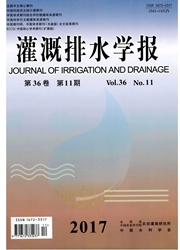

 中文摘要:
中文摘要:
利用河南省17个站点1961—2012年的气象资料,分析了降雨和潜在蒸散对冬小麦和夏玉米灌溉需水量的影响效应。结果表明,河南省冬小麦多年平均灌溉需水量为59.8~334.3 mm,夏玉米多年平均灌溉需水量为14.5~131.2mm,自南向北逐渐增大;各站点冬小麦和夏玉米灌溉需水量普遍呈下降趋势,其主要原因是生育期潜在蒸散减少和降雨量增加。降雨是影响作物灌溉需水量的首要因素,降雨在雨量和时间分布上均对灌溉需水量产生显著影响;而潜在蒸散的影响小于降雨,但不容忽视。在降雨和潜在蒸散共同影响下,冬小麦和夏玉米灌溉需水量在年际间呈现出更大的波动趋势。
 英文摘要:
英文摘要:
Based on the meteorological data of Henan province from 1961 to 2012, the effects of rainfall and potential evapotranspiration on crop irrigation requirement were analyzed. The results showed that the av- erage irrigation requirement was 59.8~334. 3 mm for winter wheat, and 14. 5~131.2 mm for summer maize in Henan province, both increasing form south to north. The irrigation requirements of winter wheat and summer maize in most stations had a downside, because of the increasing rainfall and decreasing potential evapotranspiration. Rainfall was the primary factor which influenced the irrigation requirement, and the amount and distribution in time of rainfall had a notable impact. However, the impact could not be ignored in spite of its weaker influence for potential evapotranspiration than rainfall. Irrigation requirement showed a larger fluctuation under the mutual effects of rainfall and potential evapotranspiration.
 同期刊论文项目
同期刊论文项目
 同项目期刊论文
同项目期刊论文
 期刊信息
期刊信息
